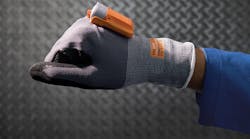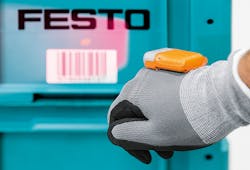Our cover story this month is all about how wearables, specifically smart glasses, can increase worker productivity. Wearables come in all shapes and sizes, and for all sorts of body parts (yes, all sorts.) One of the most intriguing, the first industrial glove, called ProGlove, allows workers to document process steps without picking up a tool, and to pick and scan at the same time. The Munich-based startup of the same name has run pilots in a few major German manufacturing facilities.
During one of these, the workers at John Deere's plant in Mannheim performed 1,000 picks a day, and ProGlove says it can save 4 seconds per pick. That equates to more than an hour a day, or a 12% efficiency increase. Add that up over a year and the ROI will make it seem like you're getting a five-finger discount.
We talked to ProGlove's spokesperson Sabrina Werner to give us some more details.
NED: How does it work?
SW: Its design, consisting of a core computing unit and a glove, perfectly adapts to industrial environments. This has already been recognized by BMW, Festo, Audi, Penny and around another 100 other organizations, as well as chancellor Angela Merkel. Our customers see ProGlove as a comprehensive solution for the instant start of Industry 4.0.
With ProGlove you work and scan at the same time, allowing for hands-free scanning, and therefore more ergonomic work. Through the integration of currently discrete functionalities, the worker saves the time of taking and replacing formerly separate tools, omitting extra steps out of the process.
NED: How does this wearable communicate with a company’s overall inventory system and what needs to be done to integrate?
SW: ProGlove is designed as a plug & play solution and can be implemented without integrational effort. We do not need to adapt the current system.
NED: So how did the idea for the ProGlove Mark come about?
Sabrina Werner: ProGlove was founded by Thomas Kirchner, Paul Günther, Jonas Girardet and Alexander Grots. Two of them are former IDEO employees and the other two have a background in the automotive industry, such as BMW. The concept was created as part of the Intel 'Make It Wearable' Challenge in 2014. The four founders thought a lot about a wearable technology and what could differentiate their product from all the fitness trackers. Paul Günther was a PhD student at BMW and recognized that everybody in production and logistics wears gloves. So they thought, Why not make a smart glove? They were the only ones developing something for the industry at the challenge in Silicon Valley. And with this challenge we won our seed financing.
NED: When the company started doing market research to see if there was a need for the product, what were some of the problems you knew the ProGlove would solve?
SW: Efficiency is the main profit driver in industrial production and logistics. Outside factors, like increasing flexibility or low-wage countries, force process managers to evaluate every solution to increase productivity by improving output quality and decreasing process time.
The human worker plays a critical, but volatile role in most production lines and warehousing. His adaptability and learning abilities are demanded qualities for modern production and logistic processes. Wearable technologies offer an enormous potential to integrate human and human-based workflows into the overall production systems. It is critical for acceptance and adoption of wearables that the user is already used to the form factor—and everybody already wears gloves every day.
NED: You made a bit of a redesign along the way, with the display going from the wrist to the back of your hand. What was the reason for that and how did that transition go? Were you hesitant or confident?
SW: We have prototypes that includes RFID, a display, motion sensors, etc. What we realized along the way is that not every technology makes sense for the user at this moment. First, it is hard to cancel these great functionalities, but in the end the crucial question is: "Will the customer pay money for that?"
For our customers the most important thing right now is to save four seconds per pick. We don't need RFID or motion tracking for that.
Currently we're working on our second product, which should offer even more information and feedback to the worker by an included display. Pilot projects will start in the end of 2017.
NED: You have several case studies on your website. Can you distill all that feedback into why a picking operation should invest in the ProGlove?
SW: ProGlove enables manufacturing and logistics staff to work faster, safer and easier. With ProGlove, the worker can save up to four seconds per pick. As an example, building one car requires about 1,500 scans. That means a lot of time savings and therefore money for the car manufacturer. The worker can scan hands-free and pick goods with both hands. This is an improvement of ergonomy and safety. The worker gets direct feedback to his working steps, which means a higher process quality.












